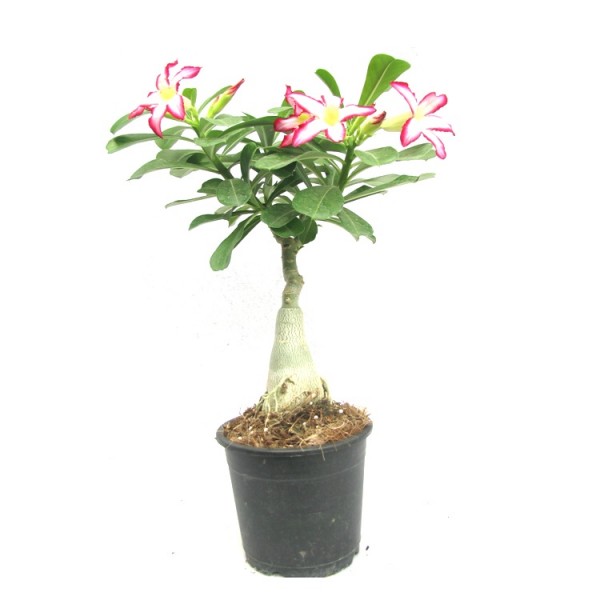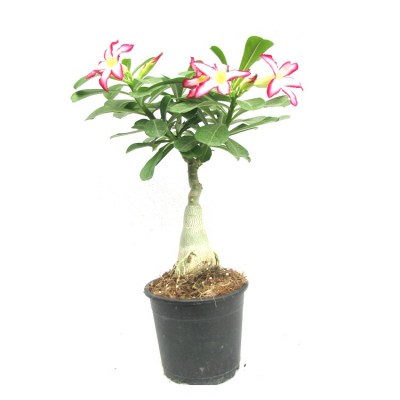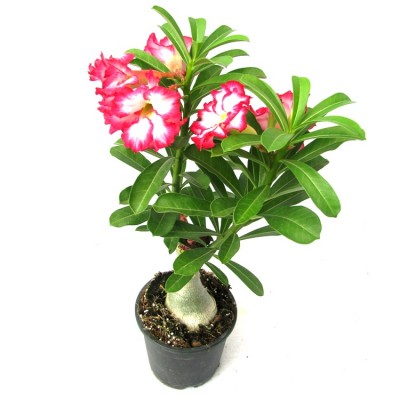This image is for reference purpose only, Photo May Slightly Different From Actual Item in Terms of Color Due to the Lighting During Photo Shooting or the Monitor's Display.
Adenium
Condition: Potted
Size: 5'' Black Plastic Pot
Height: 1-2 feet
Common Names:
Adenium Obesum, Desert Rose, Adenium obesum" Also known by the names "Sabi Star, Kudu, Mock Azalea, Impala Lily & Desert-rose.
Adenium also known as desert rose is slow growing but long-lived succulent plant. The attractive flowers of adeniums and their interesting bottle-shaped trunk make them desirable for the garden.
Adeniums are easy to grow plant and thrive in humid, tropical climate like India, Thailand, and Philippines. As hardy and tough plant Adenium needs very little care, the only way to kill one of these plants is to over water or leaves it exposed to low temperature. If a few simple precautions are taken, Adenium also thrives in cool, wet climates.
Cultivation and uses:
Adenium obesum is grown as a houseplant in temperate regions. Numerous hybrids have been developed. Adeniums are appreciated for their colorful flowers, but also for their unusual, thick caudices. They can be grown for many years in a pot and are commonly used for bonsai.
Because seed-grown plants are not genetically identical to the mother plant, desirable varieties are commonly propagated by grafting. Genetically identical plants can also be propagated by cutting. However, cutting-grown plants do not tend to develop a desirable thick caudex as quickly as seed-grown plants.
Light:
Adenium requires direct sunlight and fresh air; plants grown in shade will flower poorly, become leggy, and are more susceptible to diseases. However, it is necessary to protect the newly exposed portions (caudex) from direct sun, or sunscald may occur.
Temperature:
Adeniums in general respond to high temperatures. An ideal temperature for better growth and flowering is 30-35° Celsius, preferably accompanied by moderate to high humidity. However, growth and flowering seem to be suppressed by temperatures consistently above 38° Celsius. Dormancy is induced in all taxa when nights regularly fall below about10° Celsius. When completely dry and dormant they can tolerate near-freezing temperatures, though there is increased risk of root-rot below 10° Celsius. At 10° Celsius branch tips will be damaged, however the plant will survive; prolonged exposure below 10° Celsius causes serious damage or death.
Water:
Proper watering is the key to keeping your Adenium healthy. Frequency of watering depends on container and soil mix used to plant and of course temperature. Adenium needs more water when plants actively growing and hot summer days. During monsoon and winter water requirement is less as soil retains moisture for a longer period due to slow absorption by plants.
Soil:
Desert rose requires excellent drainage in any soil mix; if it is not provided, the roots rot, resulting in poor growth or death of the plant. The soil mix also must have moisture retention properties, along with adequate nutrients. Use a mixture of one part coarse sand, half part coco peat and half part worm compost or well rotted cow dung, which will hold some moisture but still drain nicely.
Container:
Desert rose can also be grown in any container that permits good drainage. Unglazed ceramic pots are ideal, in that they allow the soil to dry out between watering. If a clay pot is used it must be wide enough to allow for expansion of the caudex, otherwise the container may crack. Whether you use plastic or ceramic is entirely up to personal preference but you must keep in mind that clay pots dry out much faster than plastic.
Fertilizer:
During the first 2–3 yrs young plants make rapid growth if provided with adequate fertilizer, then growth slows down as they mature. Give young plants a full strength complete liquid fertilizer every 2 wks. For more mature plants, reduce or eliminate the liquid fertilizer, but use slow release fertilizer.
Repotting:
Root prune and repot every year or two, using a good draining soil mix such as described above. Plant can tolerate being root-bound (tight in the pot.)
Pruning:
Usually pruning is done to reduce overall plant size, or to selectively remove branches to 'sculpt' a more-perfect plant
Pest and Diseases:
The common enemies of Desert Rose are aphids, mealybugs, spider mites, caterpillars, sometimes scale insects and fungus. Bugs are pretty easy to handle if you observe and inspect your Desert Rose often ...you'll see the pests and can take action. Sometimes, the leaves are eaten by small worm. If the trouble is not serious, just remove the worm out of the plant.
Adenium Light of Sun & Moon(Grafted) - Adenium obesum, Desert Rose Plant
- Live plant along with Plastic pot.
- Plants height with pot is 1-2 feet and pot size is 5'' diameter.
- Plants nature is outdoor/semi shade & less watering.
- Bonsai Looking plant, easy maintenance.
- Annual Flowering & hardy plant.


